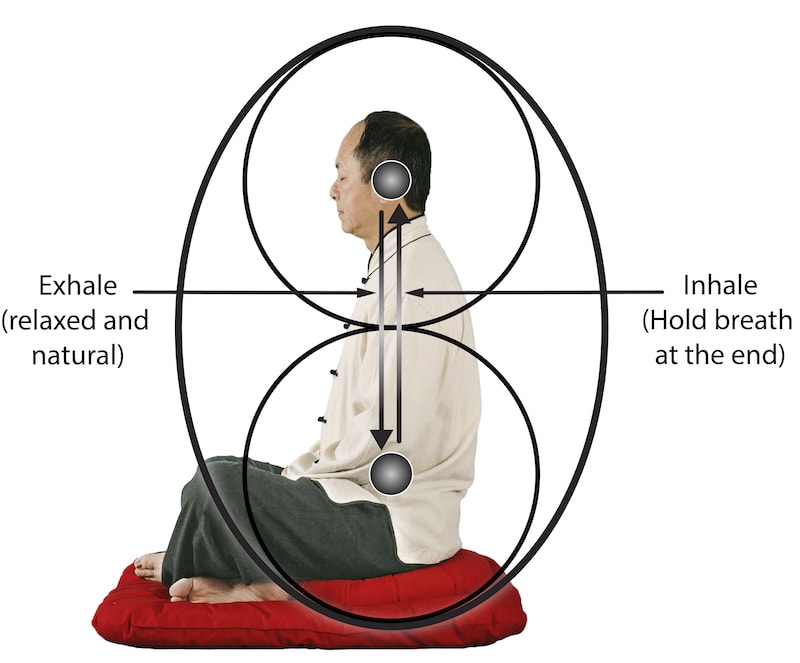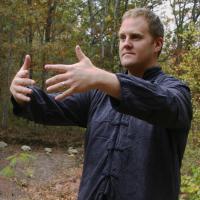Grand Circulation practice can help you to experience an expansion of your core consciousness throughout the entire body, allowing random thoughts and emotions to subside while your true self emerges. Below is a basic set of exercises so you can progressively gain skill in leading your energy to improve your health and self-awareness. You can learn in far greater detail using the book “Qìgōng Grand Circulation for Spiritual Enlightenment” by Dr. Yáng, Jwìng-Mǐng.
Energize Your Third Eye
This will allow you to stimulate your Upper Dāntián (brain energy center) and feel the physical structure known as your third eye. First, lightly tap the very top of your head and feel the most sensitive area. This is the Bǎihuì point (Gv-20)(One Hundred Meetings, 百會), located directly above your pineal gland in the center of your head. Stop tapping and focus on the feeling there. Next, tap very gently on the center of your forehead, just above the eyebrows. This is the Yìntáng point (M-HN-3)(印堂 Seal Hall), a component of your third eye, which connects energetically to the pineal gland near the center of your brain. This point, along with your upper forehead Shéntíng (Gv-24) (神庭), is commonly known as the Third Eye. After a few seconds, stop tapping and pay attention to the feeling there as you focus on it. This technique will help you develop a stronger feeling of your Upper Dāntián.

Phase 1: Meditate with Normal Abdominal Breathing for a minimum of 5-10 minutes each day, while slightly aware of your Third Eye, and gradually add time to your daily meditation. You may find it takes longer than 5-10 minutes for your thoughts to settle down. Observing the breath will help you to train your mind. A mental state of calm and ease is the goal. You may gradually feel a physical sensation of pressure or tingling in the forehead. This should be practiced as a foundation before progressing to other methods, but can also be used anytime to help relax or fall asleep. This begins the cultivation of increased Qì in the Lower Dāntián (abdomen energy center). You may wish to also begin practicing abdominal massage at this stage to help convert fat into available energy.
Phase 2: When you’re ready to progress, begin meditating with Reverse Abdominal Breathing for a minimum of 10-15 minutes each day, and gradually add time to your daily practice. Once you’ve developed a good habit of correct abdominal movement, the goal is to no longer “think” about the abdomen and remain mentally neutral, without letting the mind rise and scatter in confusion or sink down into oblivion. Sit upright and focus your intention and feeling on the Third Eye. Reverse Breathing can be more energizing and is a crucial foundation to increase the quantity of energy in the Lower Dāntián. This should be practiced regularly until it feels natural and easy, usually a minimum of 6 to 12 months, eventually to the stage of practicing without thinking about it.
Embryonic Breathing Meditation
Practice Embryonic Breathing a minimum of 20 minutes per day in a seated position, with your spine upright, ideally with crossed legs. You should have already established a regular meditation practice, progressing from normal and reverse abdominal breathing with correct body structure and an upright spine. Folding the legs in meditation “seals” the escape of energy, helping you to focus on the circulation of Qì in the torso and head. Conditioning the legs to stay folded is an ongoing practice that improves with repetition. Along with a deeper state of calm ease, the practice of Embryonic Breathing should have a feeling of gently charging the two poles as you “reside” in the center of the body.
Visualizations help set your intentions. Visualize as you inhale, light gently glowing inside like you are blowing on the coals of a fire. Remember, when you are inhaling longer than exhaling, you’re drawing your energy inward, so its important to stay warm and not get a chill. Some people will practice at this stage for years before progressing further. It is helpful to also incorporate clockwise abdominal massage before or after meditation. Within this practice, there are various Qì paths you may focus on based on your goal.
Rooting
Also known as Grounding, this standing meditation trains you to feel your “centerline”, from the crown of your head to the Qì points in the soles of the feet. Practice for five minutes, staying focused on perfect balance. There should be a subtle sensation at the Bǎihuì as if your body is suspended by a thread, lifting from above.
As you exhale, lead your mind down through the centers of your feet deep into the Earth, and “grow roots” below the feet; develop a very stable, rooted feeling. At the end of your exhalation, you may gently squat the legs, and pause your breath. Then inhale, rise back up and bring your mind to the centerline of your body. When appropriate, you may benefit from barefoot practice to reduce the insulation between your feet and the Earth’s energy, which allows your body to uptake more electrons.
Five Gates Exercise
With this whole-body standing meditation, you are circulating and refreshing your energetic circulation through the feet, hands, and head. Practice for 5-10 minutes following the theory described above, breathing slowly, quietly and deeply. As you inhale and lead Qì to your abdomen, you’re drawing fresh air and energy into the body through the head, hands, and feet (and the entire body’s skin). As you exhale, lead the Qì out of the crown, hands, and feet completely, then slightly squat.
When exhaling, you are releasing from your head, hands, and feet, extending the mind at least one foot away from your body. Place your mind on the targets outside the body in order to lead the Qì there. Inhale, and draw fresh energy in and up, gathering it into your center. As the Qì in your abdomen increases, you’ll feel a corresponding increase in the center of your head. Stay focused and calmly hold the center.

Sexual Energy Cultivation
Known as “dual cultivation” in Daoism, this meditation practice increases your hormone production by building sexual energy to a high level while restraining any release. This energizes both practitioners, balancing your energy and allowing you to absorb the heightened chemistry and nourish the entire body. This stabilizes energy in the centerline of both practitioners, leading abundant Qì into the spinal column, brain, and pineal gland.
This energy work is the original purpose of celibacy in many spiritual traditions. The practice also involves the psychological training of transcending desire and selfishness. The disturbing emotions of anger, pride, attachment/clinging, envy/jealousy, and ignorance are considered the biggest obstacles in practice and in life.
The excited Qì is drawn and held inward to energize the higher consciousness of “pristine cognition”, transforming the physical body and allowing the energy body to strengthen and become independent. Solo or with a partner, practitioners must cautiously develop skill in practicing this challenging exercise for spiritual purposes in order to properly benefit from the abundant Qì generated through this training. Those interested in this rare “secret path” can research further on the topics of Atiyoga, Yabyum, and Vajrayana. The purpose of becoming fully enlightened is to empower your compassion and your ability to help others.
The above is an original article by David Silver.




